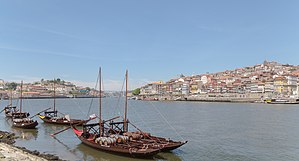
The Douro is the largest river of the Iberian Peninsula by discharge. It rises near Duruelo de la Sierra in the Spanish province of Soria, meanders briefly south, then flows generally west through the northern part of the Meseta Central in Castile and León into northern Portugal. Its largest tributary is the right-bank Esla. The Douro flows into the Atlantic Ocean at Porto, the second largest city of Portugal.

Porto, also known as Oporto, is the second largest city in Portugal, after Lisbon. It is the capital of the Porto District and one of the Iberian Peninsula's major urban areas. Porto city proper, which is the entire municipality of Porto, is small compared to its metropolitan area, with an estimated population of just 248,769 people in a municipality with only 41.42 km2 (16 sq mi). Porto's metropolitan area has around 1.8 million people (2023) in an area of 2,395 km2 (925 sq mi), making it the second-largest urban area in Portugal. It is recognized as a global city with a Gamma + rating from the Globalization and World Cities Research Network.
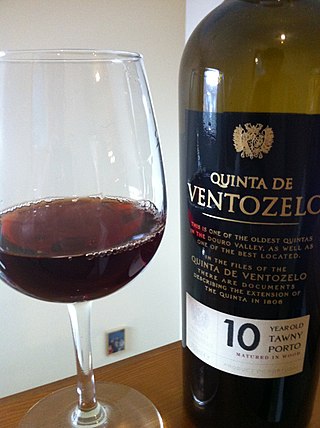
Port wine, or simply port, is a Portuguese fortified wine produced in the Douro Valley of northern Portugal. It is typically a sweet red wine, often served with dessert, although it also comes in dry, semi-dry, and white varieties.

Peso da Régua, commonly known as Régua, is a city and municipality in northern Portugal, in the district of Vila Real. The population in 2011 was 17,131, in an area of 94.86 km2 (36.63 sq mi) km².
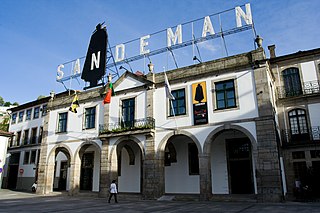
Vila Nova de Gaia, or simply Gaia, is a city and a municipality in Porto District in Norte Region, Portugal. It is located south of the city of Porto on the other side of the Douro River. The city proper had a population of 178,255 in 2001. The municipality has an area of 168.46 km². and a total population of 302,295 inhabitants (2011), making it the most populous municipality in Norte Region, and the third most populous in the country, after Lisbon and Sintra. Gaia along with Porto and 12 other municipalities make up the commonly designated Porto Metropolitan Area.

A merchant ship, merchant vessel, trading vessel, or merchantman is a watercraft that transports cargo or carries passengers for hire. This is in contrast to pleasure craft, which are used for personal recreation, and naval ships, which are used for military purposes.
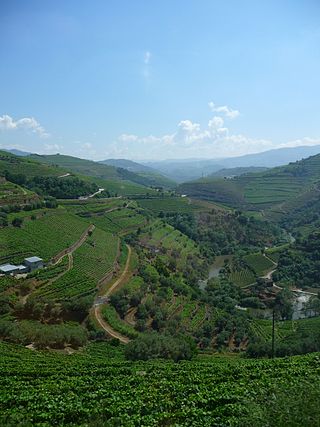
Douro is a Portuguese wine region centered on the Douro River in the Trás-os-Montes e Alto Douro region. It is sometimes referred to as the Alto Douro, as it is located some distance upstream from Porto, sheltered by mountain ranges from coastal influence. The region has Portugal's highest wine classification as a Denominação de Origem Controlada (DOC) and is registered as a Protected Designation of Origin under EU and UK law, and as a Geographical Indication in several other countries through bilateral agreements. While the region is best known for Port wine production, the Douro produces just as much table wine as it does fortified wine. The non-fortified wines are typically referred to as "Douro wines".

The North Region or Northern Portugal is the most populous region in Portugal, ahead of Lisbon, and the third most extensive by area. The region has 3,576,205 inhabitants according to the 2017 census, and its area is 21,278 kilometres (13,222 mi) with a density of 173 inhabitants per square kilometre. It is one of five regions of Mainland Portugal. Its main population center is the urban area of Porto, with about one million inhabitants; it includes a larger political metropolitan region with 1.8 million, and an urban-metropolitan agglomeration with 2.99 million inhabitants, including Porto and neighboring cities, such as Braga, Guimarães and Póvoa de Varzim. The Commission of Regional Coordination of the North (CCDR-N) is the agency that coordinates environmental policies, land-use planning, cities and the overall development of this region, supporting local governments and associations.

Entre Douro e Minho is one of the historical provinces of Portugal which encompassed the country's northern Atlantic seaboard between the Douro and Minho rivers. Contemporaries often referred to the province as simply "Minho". It was one of six provinces Portugal was commonly divided into from the early modern period until 1936, although these provinces were not recognized as official units of government.
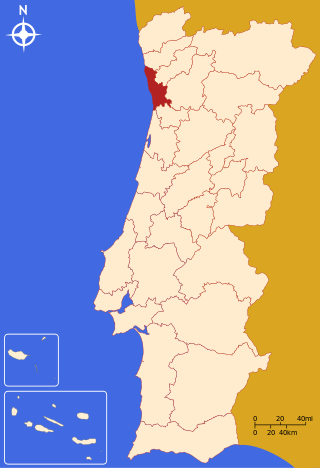
Grande Porto or Greater Porto is a former Portuguese NUTS3 subregion, integrating the NUTS2 region of Norte, in Portugal. It was abolished at the January 2015 NUTS 3 revision.
The Guindais Funicular is a funicular railway in the civil parish of Cedofeita, Santo Ildefonso, Sé, Miragaia, São Nicolau e Vitória, Portuguese municipality of Porto.
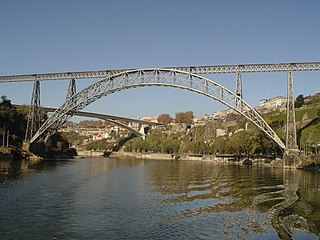
Maria Pia Bridge is a railway bridge built in 1877, and attributed to Gustave Eiffel, situated over the Portuguese Northern municipalities of Porto and Vila Nova de Gaia.

The Dom Luís I Bridge, or Luís I Bridge, is a double-deck metal arch bridge that spans the river Douro between the cities of Porto and Vila Nova de Gaia in Portugal. At its construction, its 172 metres (564 ft) span was the longest of its type in the world. It can be confused with the nearby Maria Pia Bridge, a railway bridge that was built 9 years earlier, which is similar in aspect to the Luís I bridge.
Portus Cale was an ancient town and port in present-day northern Portugal, in the area of today's Porto and Vila Nova de Gaia. The name of the town eventually influenced the name of the subsequent country of Portugal, from the 9th century onwards.

Ipojuca is a municipality in Pernambuco in eastern Brazil. As of 2020 the population according to IBGE was 97,669 and the per capita income (2007) was R$76.418 making it one of the country's highest. The settlement dates to 1560, but the official founding date is 1861 and the community was incorporated as a town in 1864. It is famous for its beaches such as Porto de Galinhas, Muro Alto, Maracaipe.

The Douro Wine Company was a government oversight organization established by the Portuguese Prime Minister Sebastião José de Carvalho e Melo, Marquis of Pombal to regulate the trade and production of Port wine. Established in 1756, one of the first official duties of the company was the delineation of the boundaries of the Douro wine region. This act essentially made the Douro the world's first regional appellation. While the boundaries of the Chianti and Tokaji wine regions were outlined in 1716 and 1737, respectively, neither of these regions were "technically" appellations in the sense of being subjected to continued government control and regulations. Under their charter, Pombal invested an immense amount of control in the Douro Wine Company to regulate all exports of Port, set production quantities limits, fix maximum and minimum prices for grapes and to serve as sole arbitrator in any disputes between vine growers and Port shippers. In 1761, the company was further granted a monopoly on the sale of brandy which was used in the fortification process of Port winemaking. The Douro Wine Company continued to operate to 1833. Today, many of it functions have been deregulated with the Instituto dos Vinhos do Douro e do Porto or being the official regulating body of Port wine and Douro table wine production.
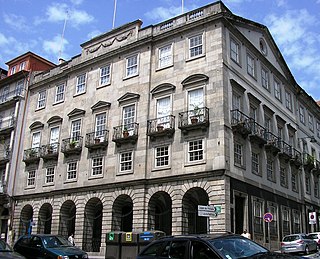
The British Factory House, also known as the British Association House, is an 18th-century Neo-Palladian building located in the northern Portuguese centre of Porto, associated with the influence of Britain in the port wine industry.

Joseph James Forrester was an English merchant and wine shipper.
Vila Nova de Gaia is a tourist destination in northern Portugal, located opposite Porto on the South bank of Douro river. The cities connect through several bridges over Douro river. Vila Nova de Gaia is home to several notable attractions, such as the Port wine cellars, Dom Luís I Bridge, the Teleferico, Monastery of Serra do Pilar, Douro Estuary and 18 km long beaches.

Barca d'Alva is a Portuguese village located in the municipality of Figueira de Castelo Rodrigo, north of the Guarda District. Barca d'Alva is also located inside the Douro International Natural Park and less than 1 km away from the Portugal-Spain border, defined by the Douro and the Águeda rivers.
